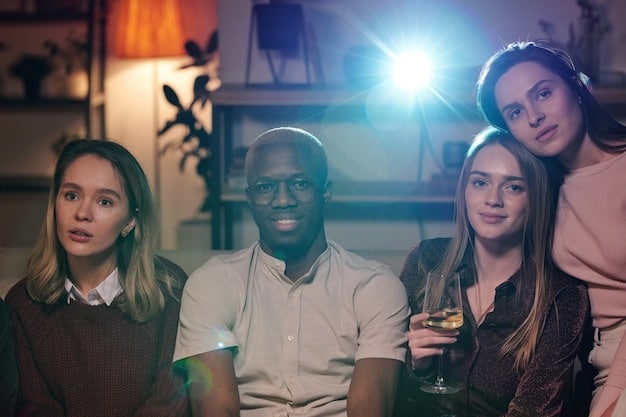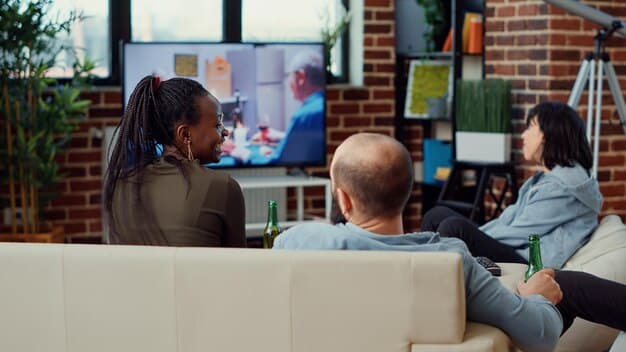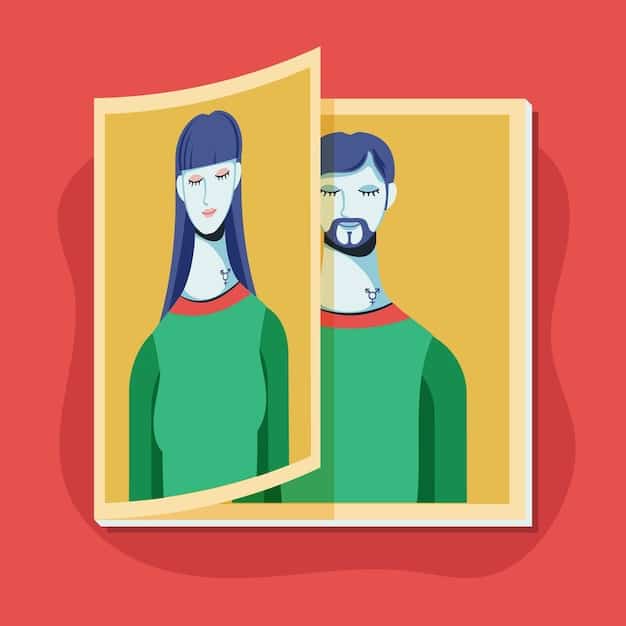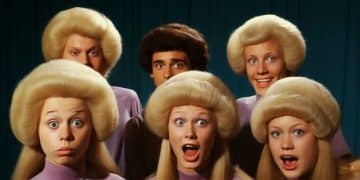Cable Originals & Representation: Progress in 2025

In 2025, cable original programming showcases some advances in representation regarding race, gender, and LGBTQ+ inclusion, yet faces persistent challenges in authentically portraying diverse experiences and avoiding tokenism.
The landscape of cable television has transformed dramatically in recent years, particularly concerning representation. But when we look at cable originals and representation: how far have we come in 2025?, a mixed bag of progress and persistent issues emerges.
The Evolution of Representation in Cable TV
Cable television has historically been a space where niche audiences could find content tailored to their interests. This has, in some ways, fostered a more diverse environment compared to broadcast television. However, the journey toward genuine representation has been far from smooth.
Early cable originals often struggled with stereotypical portrayals and a lack of diverse voices behind the camera. As viewing habits shifted and demand for more inclusive content grew, networks began to respond, albeit sometimes slowly.
Breaking Down Stereotypes
One of the key areas of progress has been the effort to move away from harmful stereotypes. While these stereotypes still exist, there’s a growing awareness of their impact and a push for more nuanced characters.
The Rise of Diverse Storytelling
Cable networks have started to embrace stories that reflect the experiences of marginalized communities, addressing complex issues and showcasing a wider range of perspectives. This shift is driven both by audience demand and a growing understanding of the importance of representation.

- More diverse casting of lead roles.
- Exploring complex narratives from underrepresented perspectives.
- Increasing the number of writers, directors, and producers from diverse backgrounds working on cable originals.
In conclusion, the evolution of representation in cable TV reflects a slow but steady movement toward more inclusive storytelling. While challenges remain, there’s a growing recognition of the need to break down stereotypes and amplify diverse voices.
LGBTQ+ Inclusion: A Closer Look
The portrayal of LGBTQ+ characters and stories on cable television has seen significant advancements. However, true inclusion extends beyond simply featuring these characters; it requires thoughtful and authentic representation.
Many cable originals have been praised for their groundbreaking portrayals of LGBTQ+ experiences, but criticisms persist regarding tokenism and shallow character development.
Positive Developments in LGBTQ+ Representation
Cable networks have spearheaded initiatives to include more LGBTQ+ characters in leading roles in recent years. In addition to simply being present, these efforts prioritize telling their stories from their perspectives.
Challenges and Areas for Improvement
Despite progress, some portrayals of LGBTQ+ characters can fall into harmful stereotypes or serve primarily as plot devices. Authentic representation requires deeper exploration of their lives, relationships, and struggles.
- Ensuring LGBTQ+ characters have fully developed personalities and storylines.
- Avoiding the “bury your gays” trope, where LGBTQ+ characters are killed off disproportionately.
- More representation behind the camera, with LGBTQ+ writers, directors, and producers shaping the narrative.
In conclusion, LGBTQ+ inclusion in cable TV has come a long way, but there’s still work to be done. Authentic representation requires a commitment to complex characters, diverse storytelling, and LGBTQ+ voices behind the camera.
Racial and Ethnic Diversity On Screen
Racial and ethnic diversity is crucial for reflecting the complex tapestry of society. Cable television has a unique opportunity to showcase a wide range of cultures and experiences, but the reality often falls short of this ideal.
While some cable originals have made strides in featuring diverse casts, others continue to perpetuate harmful stereotypes or focus primarily on white-centric narratives.
Progress in Showcasing Different Backgrounds
An increasing number of cable shows feature diverse casts, with actors from various racial and ethnic backgrounds playing prominent roles. This visibility is a positive step but must be accompanied by authentic storytelling.
The Issue of Stereotypical Portrayals
Even with diverse casting, shows can inadvertently reinforce stereotypes through the characters’ personalities, storylines, or the overall narrative. This can do more harm than good, undermining the efforts at representation.

- Ensuring that diverse characters have agency and are not simply supporting players in white-centric stories.
- Exploring the complexities of race and ethnicity, including issues of identity, discrimination, and cultural heritage.
- Having diverse writers, directors, and producers involved in the creative process from the outset.
In conclusion, racial and ethnic diversity on screen is essential, but authentic representation requires more than just diverse casting. It requires a commitment to nuanced storytelling, challenging stereotypes, and amplifying diverse voices behind the camera.
Gender Representation and Equality
Gender representation in cable television must move beyond simplistic portrayals of women as either victims or superheroes. Authentic gender equality means showcasing the full spectrum of female experiences and challenging traditional gender roles.
Cable originals have begun to feature more complex female characters, but gender bias persists both on and off screen.
The Rise of Strong Female Leads
Many cable shows feature women front and center, driving the narrative and challenging traditional gender roles. These characters are often complex, flawed, and relatable, offering a refreshing alternative to stereotypical female portrayals.
Addressing Gender Bias Behind the Camera
While on-screen representation is important, true gender equality requires addressing the gender imbalance behind the camera. More women need to be in positions of power as writers, directors, and producers.
Authentic gender equality requires efforts to challenge gender bias in the writing and directing room, which is why we observe shows like “Orange is the New Black” that tell a variety of stories through the female gaze.
- More women in positions of leadership, shaping the narratives and making key creative decisions.
- Creating a more inclusive and equitable environment for women working in the television industry.
- Challenging gender stereotypes both on and off screen.
In conclusion, gender representation and equality in cable TV are moving in the right direction, but sustained efforts are needed. This includes featuring complex female characters on screen and promoting gender equality behind the camera.
Impact of Streaming Services on Cable Diversity
The rise of streaming services has significantly impacted the landscape of cable television, particularly regarding diversity and representation. These platforms have presented both opportunities and challenges for cable networks.
Streaming services are able to capture audiences that may have been outside of cable’s radar in the past. So, can these numbers translate into real power for change?
Competition and Innovation
Streaming services have created a more competitive environment, forcing cable networks to innovate and take greater risks with their programming. This can lead to more diverse and inclusive storytelling as networks seek to attract a wider audience.
Audience Fragmentation
The proliferation of streaming services has led to audience fragmentation, which can make it more difficult for cable networks to reach a broad audience with their diverse programming. This can be a challenge for funding diverse projects.
Cable TV networks and Streaming services alike have to contend with balancing niche offerings and reaching a wide audience.
- Cable networks need to leverage their existing infrastructure and brand recognition to compete with streaming services.
- Embracing diverse storytelling as a key differentiator in the crowded media landscape.
- Collaborating with streaming services to reach a wider audience with diverse programming.
The rise of streaming services has changed media consumption habits as well as media creation incentives. They compete and innovate with their platforms to offer unique cable services to the masses.
The Future of Cable Originals and Representation
Looking ahead, the future of cable originals and representation hinges on a number of factors, including continued audience demand for diverse content, a commitment from networks and studios, and the ongoing evolution of the media landscape.
What concrete changes will cable networks and creative teams implement in the coming years?
Continued Progress and Challenges
While progress has been made, challenges remain in ensuring authentic representation and addressing systemic inequalities within the television industry.
Audience Demand and Accountability
Ultimately, the demand for diverse content will drive further progress. Audiences need to hold networks and studios accountable for their representation efforts and support shows that authentically reflect a wide range of experiences.
Cable Originals are consistently improving in their content, which sets the bar for TV networks across the media landscape.
- Increase funding for diverse programming and initiatives.
- Providing greater opportunities for underrepresented groups within the television industry.
- Holding networks and studios accountable for their representation efforts.
In conclusion, the future of cable originals and representation: how far have we come in 2025? ultimately depends on sustained efforts from all stakeholders. By working together, we can create a more inclusive and equitable television landscape that reflects the diversity of our society.
| Key Point | Brief Description |
|---|---|
| 📺 Evolving Representation | Cable TV is progressing in diversity but faces challenges. |
| 🌈 LGBTQ+ Inclusion | Significant strides, yet tokenism remains an issue. |
| 🎭 Racial Diversity | More diverse casts, but battling stereotypes is ongoing. |
| 👩💼 Gender Equality | Strong female leads emerge as bias persists. |
Frequently Asked Questions
▼
Cable TV has seen advancements in depicting race, gender, and LGBTQ+ identities. However, progress is ongoing, with authenticity and stereotype avoidance as key challenges. These issues provide opportunities for growth.
▼
Challenges include tokenism, underdeveloped characters, and harmful tropes. Accurate portrayals require complex, diverse characters and more LGBTQ+ voices behind the camera. The success of LGBTQ+ characters in shows like ‘Queer as Folk’ display how successful this can be.
▼
Cable TV can address racial stereotypes by ensuring characters have agency and aren’t just support for white-centric stories. The shows should explore the intersection of race, ethnicity, identity, discrimination, and cultural heritage by showcasing what makes this group unique.
▼
More female writers, directors, and producers must be in leadership roles to shape narratives with an appreciation for women’s perspectives. Gender equality behind the camera is critical to portray women accurately on screen.
▼
Streaming creates competition, pushing cable TV to innovate and take risks with diverse programming. Fragmentation can challenge the reach of diverse content, but also leads the industry to embrace and appeal to niche target audiences.
Conclusion
While cable originals have made strides in representation, progress remains ongoing. Real change means creating authentic, complex characters and amplifying diverse voices both in front of and behind the camera.





